The Flag in WWII
During World War II, the American flag emerged once again to rally and inspire the nation in a time of crisis. On the battlefield and the home front, the flag symbolized the values and freedoms the nation was fighting for. By the end of the war, the flag had become the emblem of a superpower with a mission to promote democracy around the world.
Before the nation entered the war, the flag was more commonly raised to oppose American involvement in international conflicts. Yet such calls to put America “first†quickly evaporated after the Japanese attack on the U.S. military base at Pearl Harbor, Hawaii, on December 7, 1941. As had happened at Fort McHenry in 1814 and Fort Sumter in 1861, the image of the Star-Spangled Banner under attack inspired a wave of patriotism and unity and renewed popular reverence for the flag.
While the military strength of the U.S. armed forces transformed the American flag into an icon of freedom and power abroad, the federal government also depended on the flag to mobilize and sustain support for the war at home. Posters, billboards, magazines, and movies waved the Star-Spangled Banner to urge Americans to buy bonds, produce for victory, ration and recycle, and make other personal sacrifices for the greater good. Such appeals linked the flag not only to a sense of loyalty but to shared cultural values, casting the war as a struggle to defend the “American way of life†against the forces of totalitarianism.
Yet this vision of America as a defender of democracy was challenged by the realities of racism and inequality. The same flag that liberated Nazi camps in Europe flew over internment camps in the western United States, where Japanese Americans were imprisoned by executive order from 1942 until the war’s end. The American G.I.s who fought together under the flag served in racially segregated units. During the war, African Americans and other minority groups used the Star-Spangled Banner not only to display their patriotism, but to call attention to these injustices and claim their equal rights as American citizens.
The Flag in the Sixties-
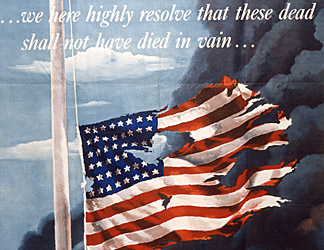
Office of War Information poster
The powerful image of the tattered flag flying at half-staff evoked the nation’s grief and outrage after the Japanese attack on Pearl Harbor and urged Americans to channel those emotions into action.
-
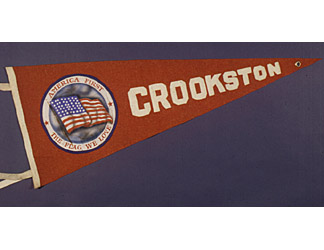
“America First†pennant
Crookston, Minnesota. The America First Committee, an isolationist group that opposed U.S. intervention in World War II, was founded in 1940. Although it had attracted a large following, the group dissolved shortly after the attack on Pearl Harbor in December 1941.
-

Milk-bottle collar
As the nation’s industries shifted to war production, many consumer items became scarce commodities. Rationing and recycling became a patriotic duty, a way for every American to pitch in and support the war effort.
-
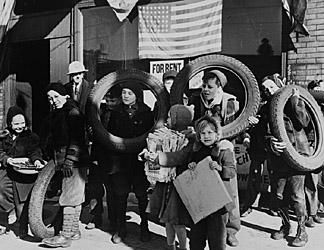
Pitching in on the Home Front
Children collecting scrap for the war effort, Chicago, 1942
-
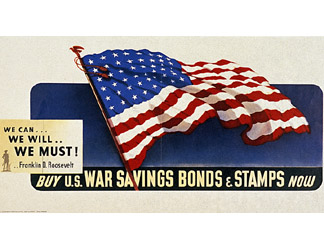
U.S. Treasury Department poster
This image of the American flag appeared on thousands of billboards nationwide in the spring of 1942. Its eye-catching design and straightforward message linked the flag to wartime ideals of patriotism, service, and sacrifice.
-
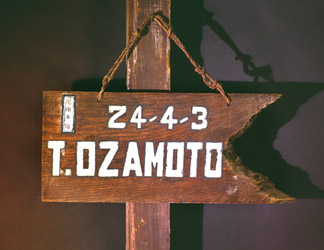
Manzanar barracks sign
On February 19, 1942, President Roosevelt authorized the internment of people of Japanese descent in the interest of national security. Almost 120,000 American men, women, and children were forced from their homes into detention camps.
-

War Relocation Authority Center
Manzanar, California, 1942. Dorothea Lange; Courtesy of National Archives.
-

Ella Watson, August 1942
Photographer Gordon Parks was shocked by the racial prejudice he encountered in the nation’s capital. He used the flag ironically to express these feelings in his famous portrait of Watson, who worked as a cleaning woman in a government office building.
-
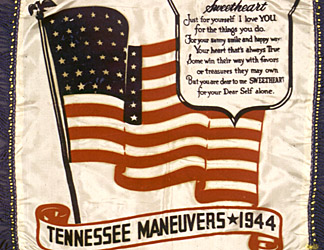
Souvenir pillow top
Mementos given by servicemen to loved ones often included the flag to symbolize and reinforce the emotional bonds of home, family, and nation. The Tennessee Maneuvers were battlefield training exercises conducted from 1941 until 1944.
-
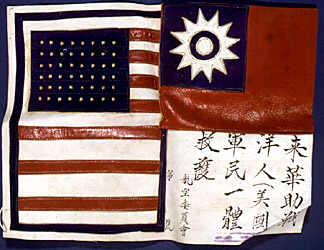
Blood Chit
Escape flags, or blood chits, served as survival tools for downed U.S. fliers. This patch features a message in Chinese that identifies the bearer as an American and asks for help and protection.
-
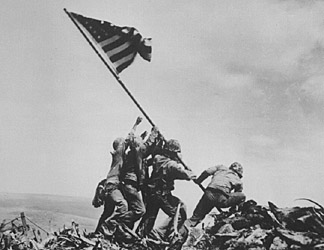
Raising the flag at Iwo Jima
On February 23, 1945, photographer Joe Rosenthal snapped a picture as five marines and a navy hospital corpsman raised a flag to signal the capture of Mount Suribachi. The image rallied the nation during the final months of World War II.
-

GI’s handmade flag (1)
Joseph E. Fennimore was a scout with the Fourth Infantry Division, which spearheaded the Allied invasion of Germany in early 1945. When he discovered his company command post had no American flag to fly, Fennimore created one using a captured Nazi flag, a blue dress uniform, and some salvaged red fabric.
-

GI’s handmade flag (2)
Joseph Fennimore’s squad (Fennimore kneeling, second from left) proudly posed with the handmade flag on May 7, 1945, the day Germany surrendered unconditionally to the Allies.












